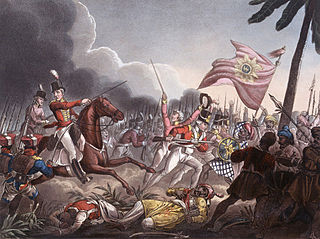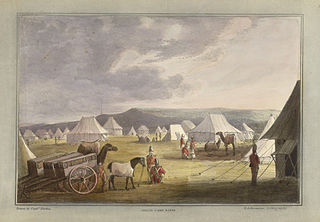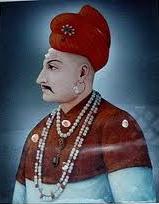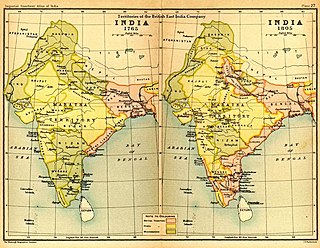Related Research Articles

The Third Battle of Panipat took place on 14 January 1761 between the Maratha Empire and the invading army of the Durrani Afghan Empire. The battle took place in and around the city of Panipat, approximately 97 kilometres (60 mi) north of Delhi. The Afghans were supported by four key allies in India: the Pashtun Rohillas under the command of Najib ad-Dawlah, the Baloch Khanate of Kalat, and the Oudh State under Shuja-ud-Daula as well as elements of the declining Mughal Empire. The Maratha army was led by Sadashivrao Bhau, who was third-highest authority of the Maratha Empire after the Chhatrapati and the Peshwa. The bulk of the Maratha army was stationed in the Deccan Plateau with the Peshwa.

The Maratha Empire, or the Maratha Confederacy, was an early modern Indian confederation that came to dominate much of the Indian subcontinent in the 18th century. Maratha rule formally began in 1674 with the coronation of Shivaji as the Chhatrapati. The Marathas were responsible for weakening the Mughal control over the Indian subcontinent. Maratha rule officially ended in 1818 with the defeat of Peshwa Bajirao II at the hands of the English East India Company.

The Second Anglo-Maratha War (1803–1805) was the second conflict between the British East India Company and the Maratha Empire in India.

The Third Anglo-Maratha War (1817–1819) was the final and decisive conflict between the English East India Company and the Maratha Empire in India. The war left the Company in control of most of India. It began with an invasion of Maratha territory by British East India Company troops, and although the British were outnumbered, the Maratha army was decimated. The troops were led by Governor General Hastings, supported by a force under General Thomas Hislop. Operations began against the Pindaris, a band of Muslim mercenaries and Marathas from central India.

Balajirao Bhat, also known as Nana Saheb, was the 8th Peshwa of the Maratha Empire in India. He was appointed as Peshwa in 1740 upon the death of his illustrious father, the Peshwa Bajirao I.

Balaji Vishwanath Bhat (1662–1720) was the first of a series of hereditary Peshwas hailing from the Bhat family who gained effective control of the Maratha Empire during the 18th century. Balaji Vishwanath assisted a young Maratha Emperor Shahu to consolidate his grip on a kingdom that had been racked by civil war and persistently intruded on by the Mughals under Aurangzeb. He was called the Second Founder of the Maratha State. Later, his son Bajirao I became the Peshwa.

Shrimant Peshwa Baji Rao II was the 13th and the last Peshwa of the Maratha Empire. He governed from 1795 to 1818. He was installed as a puppet ruler by the Maratha nobles, whose growing power prompted him to flee his capital Poona and sign the Treaty of Bassein (1802) with the British. This resulted in the Second Anglo-Maratha War (1803–1805), in which the British emerged victorious and re-installed him as the titular Peshwa. In 1817, Baji Rao II joined the Third Anglo-Maratha War against the British, after they favoured the Gaekwad nobles in a revenue-sharing dispute. After suffering several battle defeats, the Peshwa surrendered to the British, and agreed to retire in return for an estate at Bithoor and an annual pension.

Nana Fadnavis, born Balaji Janardan Bhanu, was an influential minister and statesman of the Maratha Empire during the Peshwa administration in Pune, India. James Grant Duff states that he was called "the Maratha Machiavelli" by the Europeans.

Mahadaji Shinde later known as Mahadji Scindia was a Maratha statesman and ruler of Ujjain in Central India. He was the fifth and the youngest son of Ranoji Rao Scindia, the founder of the Scindia dynasty.

Malhar Rao Holkar was a noble subedar of the Maratha Empire, in present-day India. He was one of the early officers along with Ranoji Scindia to help spread the Maratha rule to northern states and was given the estate of Indore to rule by the Peshwas, during the reign of the Maratha emperor Shahu I. He was founder of the Holkar dynasty that ruled Malwa.

Shrimant Daulat Rao Shinde (Sindhia) was the Maharaja (ruler) of Gwalior state in central India from 1794 until his death in 1827. His reign coincided with struggles for supremacy within the Maratha Empire, and wars with the expanding East India Company. Daulatrao played a significant role in the Second and Third Anglo-Maratha wars.

The Maratha Conquests were a series of conquests in the Indian subcontinent which led to the building of the Maratha Empire. These conquests were started by Shivaji in 1659, from the victory at the Battle of Pratapgad against Bijapur. The expansion of the empire was limited and interrupted by the Mughal conquests of south India by Mughal emperor Aurangzeb. Marathas were forced to defend their territories against the overwhelmingly strong Mughal army in the 27 years long Deccan wars. They were able to defend their territories and gain an upper hand over Mughals in the sustained conflict.

Sadashivrao Peshwa was son of Chimaji Appa and Rakhmabai and the nephew of Baji Rao I. He was a finance minister during the reign of Maratha emperor Chhatrapati Rajaram II. He led the Maratha army at the Third Battle of Panipat.

Ranoji Shinde the founder of the Scindia from maratha caste dynasty that produced outstanding Maratha military commanders during the 18th century. Later the Scindia served as vassals of the British from the northern Princely state of Gwalior.

Shrimant Vishwasrao Peshwa was the eldest son of Balaji Baji Rao Bhat, Peshwa of Pune of the Maratha Empire and also was the heir to the title of Peshwa of the Maratha Empire. Shrimant Vishwasrao had received training in administration and warfare from the age of 8 years. He had impressed the Maratha infantry by his performance at Sindkheda and Udgir battle 1760. His specialities were swordsmanship and archery or Dhanurvidya. During Battle of Udgir, he was unstoppable with the bow and arrow while mounted on an war-elephant Vishwasrao was tall and well-built following the genetic constitution of the Peshwa family. Although, he looked exactly like the younger version of his grandfather Peshwa Bajirao, Vishwasrao had blue eyes. As per Sardesai and few other authors that named him the most handsome among the Peshwa men, Vishwasrao followed a strenuous gym routine and performed Kawaiti. Kaustubh Kasture states in his book, "Sakalraj Karya Dhurandar Sadashivrao Bhausaheb" that Sadashivrao Bhau,that is his uncle saw that Vishwasrao received thorough military and administration training. It is believed as per some sources, it was Nanasaheb Peshwa who introduced regular army training and added the best armour to the Maratha army.

The Battle of Koregaon was fought on 1 January 1818 between the British East India Company and the Peshwa faction of the Maratha Confederacy, at Koregaon Bhima.
The Battle of Rakshasbhuvan in India was fought on 10 August 1763. After the defeat of the Marathas at the Battle of Panipat, their rivals started seizing the opportunity to recover their losses in the past at the hands of Marathas. Particularly, the Nizam of Hyderabad wanted to recover territory he had lost at the Battle of Udgir where all of his dukes and earls were killed. He decided to launch a war on the Marathas.
The Battle of Bhopal, was fought on 24 December 1737 in Bhopal between the Maratha Empire and the combined army of the Nizam and several Mughal generals.

The Maratha Army was the land-based armed forces of the Maratha Empire, which existed from the late 17th to the early 19th centuries in India.
The Bhat Peshwa family earlier known as Bhat family is a prominent Indian Chitpavan Brahmin family who dominated India for around 100 years in the late 18th century and early 19th century. Most of the members in this family were the Peshwas in the Peshwa Era of the Maratha Empire, and Peshwa later became their family name. During their regime, most of the Indian subcontinent was under their control. The last Peshwa, Baji Rao II, was defeated by the British East India Company in the Third Anglo-Maratha War in 1818. The territory was annexed to the British East India Company's Bombay Presidency, and he was pensioned
References
- ↑ Thomas Edmund Farnsworth Wright; Oxford University Press (15 November 2006). A dictionary of world history. Oxford University Press. pp. 401–. ISBN 978-0-19-920247-8 . Retrieved 15 May 2011.
- ↑ Viṭhṭhala Gopāḷa Khobarekara (2002). Konkan, from the earliest to 1818 A.D.: a study in political and socio-economic aspects. Snehavardhan Pub. House. Retrieved 11 September 2011.